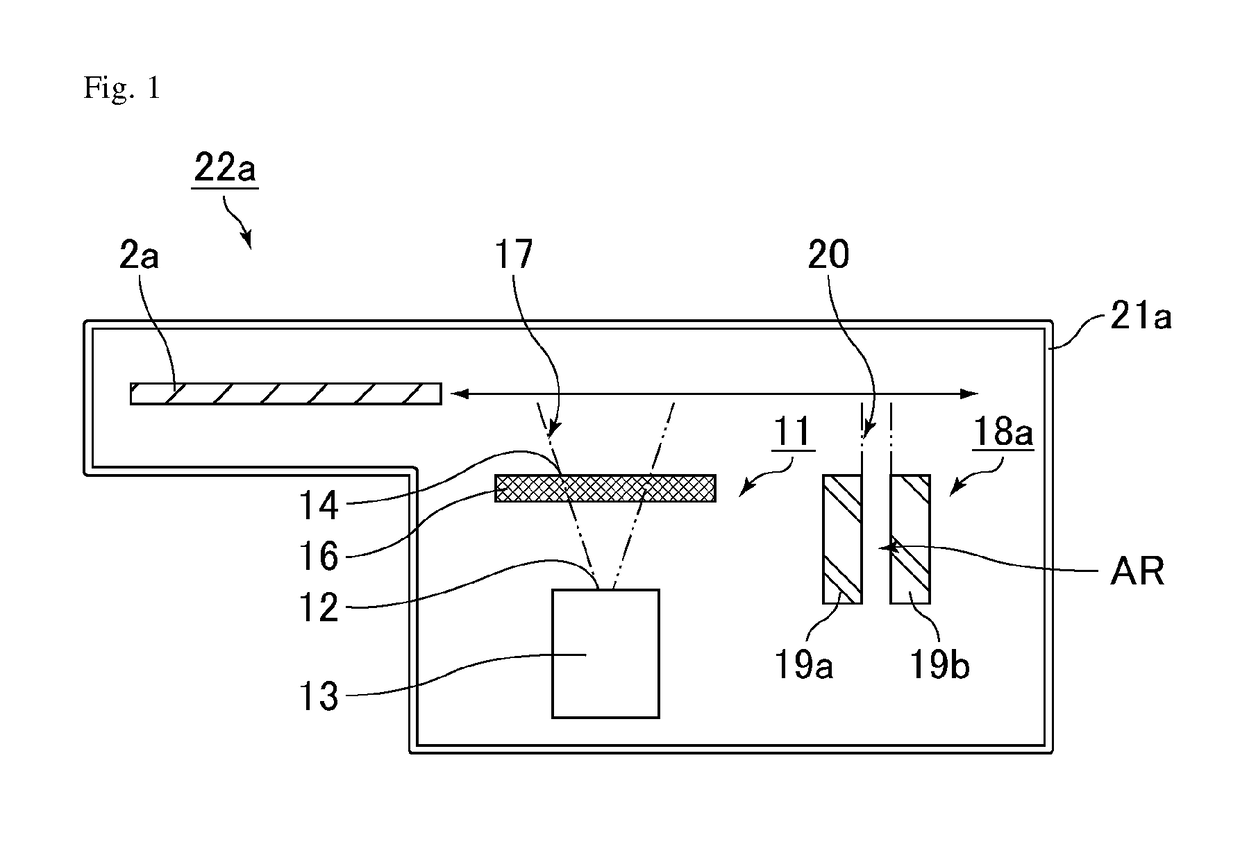Method for producing organic electroluminescent display panel
a technology of electroluminescent display panels and electroluminescent light, which is applied in the direction of basic electric elements, electrical equipment, semiconductor devices, etc., can solve problems such as display quality degradation, and achieve the effects of improving production efficiency, preventing color mixture, and improving display quality
- Summary
- Abstract
- Description
- Claims
- Application Information
AI Technical Summary
Benefits of technology
Problems solved by technology
Method used
Image
Examples
embodiment 1
[0036 describes the case of performing the vapor deposition and the etching treatment for the luminescent material of each luminescent color in the same chamber.
[0037]First, the configuration of an apparatus unit used in the step of forming light-emitting layers is described with reference to FIG. 1. FIG. 1 is a schematic cross-sectional view illustrating an apparatus unit used in the step of forming light-emitting layers in production of an organic EL display panel of Embodiment 1. As illustrated in FIG. 1, an apparatus unit 22a used in the step of forming light-emitting layers includes a vapor deposition apparatus 11 and a plasma treatment apparatus 18a. The vapor deposition apparatus 11 and the plasma treatment apparatus 18a are disposed, in the given order, in a chamber 21a.
[0038]The vapor deposition apparatus 11 includes a vapor deposition source 13 provided with nozzles 12 configured to eject vapor deposition particles, and a mask 16 provided with openings 14. A limiting plat...
embodiment 2
[0057]FIG. 3 is a schematic cross-sectional view illustrating an apparatus unit used in the step of forming light-emitting layers in production of an organic EL display panel of As illustrated in FIG. 3, an apparatus unit 22b used in the step of forming light-emitting layers includes the vapor deposition apparatus 11 and the plasma treatment apparatus 18a. The vapor deposition apparatus 11 and the plasma treatment apparatus 18a are disposed respectively in chambers 21b and 21c. The chambers 21b and 21c are divided by a shutter (not illustrated), for example, so that the apparatus unit 22b can move the target substrate 2a between the chambers 21b and 21c without allowing the substrate to be out of the chambers. By performing the respective treatments (vapor deposition and etching) while moving the target substrate 2a in the directions of the arrow in the apparatus unit 22b, light-emitting layers are formed. There are three apparatus units 22b for the respective luminescent colors. S...
embodiment 3
[0062]FIG. 4 is a schematic cross-sectional view illustrating an apparatus unit used in the steps (steps a to c) of forming light-emitting layers in production of an organic EL display panel of First, the treatment is performed using an apparatus unit 22c as illustrated in the step (a) of FIG. 4. The apparatus unit 22c includes, in a chamber 21d, a vapor deposition apparatus 11R for the luminescent material of the luminescent color R. In such an apparatus unit 22c, the luminescent material of the luminescent color R is vapor-deposited by the vapor deposition apparatus 11R while a target substrate 2b is moved in the directions of the arrow.
[0063]Next, treatments are performed using an apparatus unit 22d as illustrated in the step (b) of FIG. 4. The apparatus unit 22d includes in the given order, in a chamber 21e, a plasma treatment apparatus 18R for the luminescent material of the luminescent color R and a vapor deposition apparatus 11G for the luminescent material of the luminescen...
PUM
| Property | Measurement | Unit |
|---|---|---|
| thickness | aaaaa | aaaaa |
| thickness | aaaaa | aaaaa |
| frequency | aaaaa | aaaaa |
Abstract
Description
Claims
Application Information
 Login to View More
Login to View More - R&D
- Intellectual Property
- Life Sciences
- Materials
- Tech Scout
- Unparalleled Data Quality
- Higher Quality Content
- 60% Fewer Hallucinations
Browse by: Latest US Patents, China's latest patents, Technical Efficacy Thesaurus, Application Domain, Technology Topic, Popular Technical Reports.
© 2025 PatSnap. All rights reserved.Legal|Privacy policy|Modern Slavery Act Transparency Statement|Sitemap|About US| Contact US: help@patsnap.com



